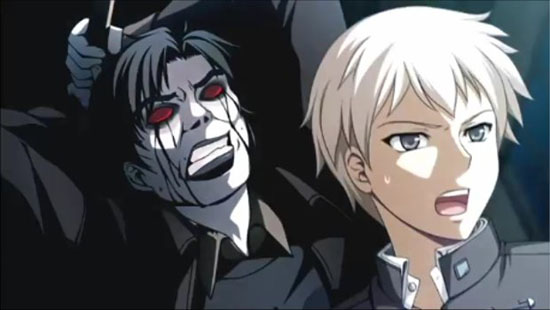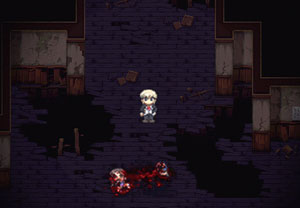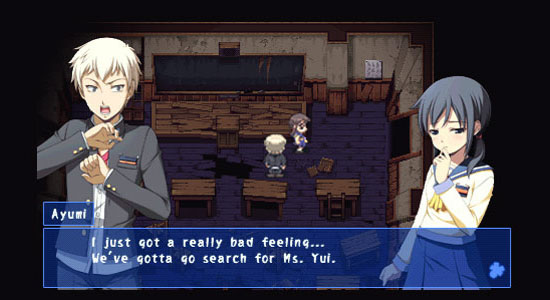
As someone who suffers the odd Bloody Mary nightmare, Corpse Party’s opening scene holds an immediate resonance. A chanting ritual deposits a group of fun loving high school students in a collapsing school created by the psychic suffering of four murdered children. There is no way out. Someone screwed up the ceremony. They are doomed.
Corpse Party started as an RPG Maker project in the mid-90s. It’s had some remakes and a couple manga series, but it’s still pretty much about RPG sprites exploring tile-based rooms. Immediate comparisons can be drawn to Sweet Home—the seminal Dragon Quest-styled Survival Horror—but it’s easier to liken it to a visual novel. Unlike visual novels, Corpse Party has you actually walking through the world instead of fading out between text binges, but the core conceit (click through dialogue to progress) is in full effect.

Any game where you read more than you play is a hard sell. Arguing against “why didn’t they just write a book?” is an uphill battle, but if there’s any genre where story can trump gameplay it’s horror. When watching a Halloween movie you can laugh at the moron who can’t even get away from the snails-paced serial killer. Put that same chase in a game and it’s not funny anymore. You don’t know which doors are unlocked. You don’t know if your assailant will kill you in one hit. You can’t remember if you saved. Was it ten minutes ago? Was it half an hour?
So horror can get away with a little less gameplay, because an entire game where you run away from serial killers would be exhausting. Instead, horror games ply their trade by making you run away from a scary ghost for five minutes and then spending the next fifty minutes threatening you with fakeout scares. You’re hearing strange voices on the wind, you’re reading violent bulletins posted on the walls, and all you can think about is that the ghost of a murdered seven year old could show up at any moment and drag you to an early grave.
Seven-year-old antagonists with sugar-sweet voices and holes carved into their faces is a weird sort of dichotomy, but if Japanese horror loves anything it’s murderous undead children. The combination of cute and horrible is immediately reminiscent of the Higurashi visual novels and anime. Both series share a need to inflict violence on impressionable youngsters. Though, unlike Higurashi, Corpse Party’s character designs don’t scream full-blown moe, but their enormous eyes and “W-w-w-watashi wa…” stammering cut it close. Listening to them ruminate on tales of awful murder while staring at their cutesy portraits is strange, to say the least.
And it’s not always good. The youngest cast member, eighth grader Yuka, fills the insufferable “imouto-chan” role. I don’t profess to know a lot of fourteen-year-old girls, but I’m reasonably certain not one of them in the entire universe has ever complained about having to “go potty.” “If they wanted a girl who both looks and acts like a six year old, why not just make a six year old?” we ask. Oh right, because a game like this needs to sell itself to every niche demographic it possibly can and Yuka’s pathetic caterwauling fits a certain archetype.

On the other hand, the coquettish Seiko steals the spotlight. She’s charming, unabashed, and responsible for the precious few uplifting moments in a game that is mostly about dead teenagers. Seiko is where the cuteness and the anime-spin show their value. “Happy-go-lucky” is not a trait we associate with horror. The Ring and Ju-On have no Seiko. Maybe this is to their detriment. Seiko reminds us, even when there are psychic ghosts with bloody scissors, there’s always something to hope for. Were it not for one miserable flashback, she’d be an easy pick for 2011’s best character.
But there’s a reason why the horror genre doesn’t include more Seikos: positive attitudes neuter the tension. Even when things are at their most dire, there’s always a little too much hope. That Silent Hill/Fatal Frame sense of dread exists here too, but not to the same degree, not even when playing it in the dark with my face inches from the screen. Death only comes in scripted moments, when you’re caught by a (rare) wandering ghost or have made an incorrect choice. The game professes to be horror, but often it’s only as deadly as a King’s Quest game.
 Corpse Party has its scary bits, sure, but it’s easier to interpret the game as an exceptionally deadly murder mystery, not survival horror. There’s a way to break the school’s evil spell, but some twist always fouls it up at the last moment. Each chapter ends on in a crescendo that practically begs you to proceed. New antagonists are added to the mix. No one is to be trusted. But still… I’m just reading. I’m clicking through text boxes and watching the one-frame animations of people flinching in pain. And just as I’m getting bored, every single time, something happens.
Corpse Party has its scary bits, sure, but it’s easier to interpret the game as an exceptionally deadly murder mystery, not survival horror. There’s a way to break the school’s evil spell, but some twist always fouls it up at the last moment. Each chapter ends on in a crescendo that practically begs you to proceed. New antagonists are added to the mix. No one is to be trusted. But still… I’m just reading. I’m clicking through text boxes and watching the one-frame animations of people flinching in pain. And just as I’m getting bored, every single time, something happens.
Instead of paging through text, I’m helping Yuka flee for her life. I dash up a winding staircase. Every door I come across is locked! I hit a dead end. In this moment I know what the Friday the 13th fodder were feeling as they tripped all over themselves and let the idiot in the hockey mask catch up to them. Yuka’s pursuer callously calls her name as he saunters up the stairs. His jibes appear as subtitles in the corner of the screen. I am trapped.
These brief scenarios are electric. The moments of pure panic, uncommon though they may be, are how Corpse Party justifies itself as a video game and not an anime where you push buttons to proceed. It still has its visual novel caveats: it’s mostly text and there’s a smidgen too much otaku bait to recommend it to the average joe. Still, there’s something there. Corpse Party is the video game equivalent of a page-turner. Sometimes it’s annoying, sometimes it’s trite, but I always needed to see the next twist.
Publisher: Xseed Games
Developer: Team GrisGris, 5pb.
System: PSP (PSN)
Available: Now

